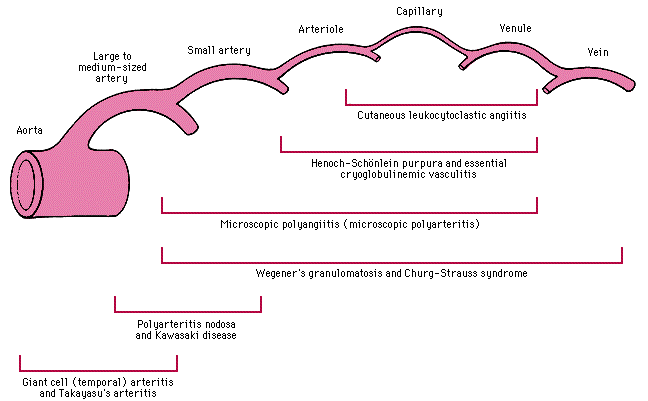CIDPUSA.ORG
Breast Cancer Guide
continue to next page of breast cancer
Sat, 31 May 2008 17:55:07
By CIDPUSA, MD.,
VASCULITIS
What is vasculitis?
Causes of vasculitis
What is systemic vasculitis?
Some important types of vasculitis
Treatment
 What is vasculitis?
What is vasculitis?In various connective tissue diseases, and especially in lupus, vasculitis is caused by the formation of immune complexes and autoantibodies.
What is Vasculitis Systemic vasculitis is a type of vasculitis that may affect any part of the body. It is always a very serious disorder, properly treated has a favorable outcome, and it can be life threatening. In most cases, intensive treatment is necessary.
The gravity and disease pattern of the different types of vasculitis vary greatly, with respect to the internal organs in which blood vessels are inflamed. If blood vessels are inflamed, the organ itself will undoubtedly be affected too. As such, a patient with polyarteritis and with inflammation of the kidneys and the brain is not comparable to a patient with skin involvement only.
Sub Types of Vasculitis Classic Polyarteritis Nodosa (PAN) This is a necrotic (local dying off of tissue) type of vasculitis of the small and medium-sized arteries. Every organ in the body may be affected but there is a predisposition to involve the kidneys and internal organs, next to the muscles and joints. The average age of the onset of the disease is 45, and it occurs 3 times more in males than in females. Enkele vormen van vasculitis
Allergic angiitis and granulomatosis (Churg-Strauss Syndrome) Differs from polyarteritis nodosa by a more frequent involvement of the lung capillaries, by affecting a wider range of blood vessels and by the formation of granulomas (small and nodular inflammatory lesions) in and round the blood vessels. All of this is accompanied by a serious form of asthma, and an increased number of eosinophiles in the blood (type of white blood cell important in allergies) and infiltration of eosinophiles in the body tissue. The patients affected are of the same age group as in polyarteritis nodosa, with a slightly higher male predominance. The disease is rare but exact figures are not known.
Hypersensitivity vasculitis Wagners This is a group of diseases in which various clinical syndromes occur which have inflammation of the small blood vessels, including the small arteries, capillaries and venules, in common. Especially the latter are likely to become involved (venulitis). Although all organs may be involved, manifestations of the skin will dominate the clinical symptoms. The outcome of the disease tends to be positive, as there is an indication of the cause. This can be a drug, a foreign protein or a bacterium. Other immune complexes may also be of significance.
Wegener's Granulomatosis The cause of this disease is not known. It is a combination of a necrotic granulomatous vasculitis of the upper and lower respiratory tract, glomerulonefritis (inflammation of the kidneys) and varying degrees of inflammation of the small blood vessels.
It is a rare disease with a slight male predominance. First manifestations are situated at the level of the upper respiratory tract with sinus inflammation, inflammation of the nose, nose blocking, inflammation of the ear, etc. Occasionally there is inflammation of the dental gums, nose bleeds, throat ache. In most cases the lungs are involved although only one third of the patients complains about it. Those suffering from it, complain about coughing, shortness of breath and chest pains.
Very typical for Wegener's granumatolosis is the presence of ANCAs. These are autoantibodies directed against components in the cytoplasm of white blood cells. It is a very serious disorder requiring very intensive treatment. The prognosis of the disease has changed thanks to cyclofosphamide (Endoxan).
Please continue to Giant cell vasculitis
God is our Guide